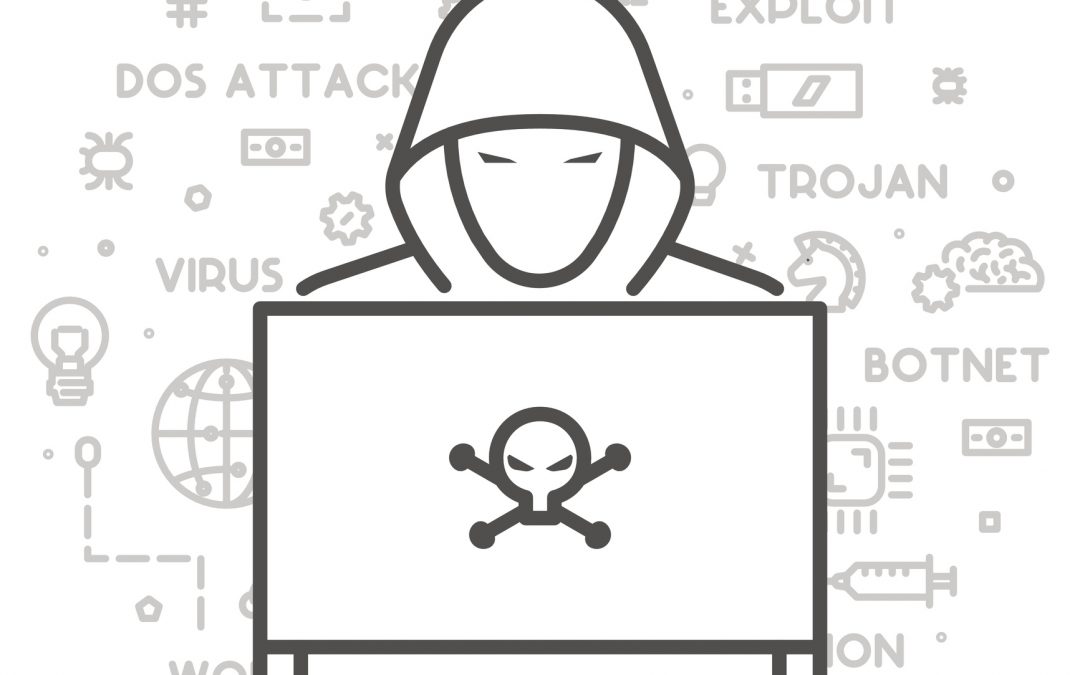
by Felicien | Sep 14, 2019 | Education
Cybercriminals no longer act alone. Find out the strategies and means cybercriminal networks are using to launch dangerous attacks against your organization.
According to technology industry blogs, cybercrime incidents are growing by 15 percent each year and cybercrime has become the most profitable type of criminal activity around the globe. Cybercriminals are no longer acting alone and carrying out destructive activities that are relatively simplistic. Instead, cybercriminals have become more sophisticated in their approach. Activities are more damaging and organized. IBM’s CEO and president has stated that the new cybercriminal dangers are “the greatest threat to every profession, every industry, every company in the world.” Being aware of the fact that cybercriminal activity is now executed using the same types of structures and approaches seen in businesses can help IT leaders guard against the dangers cybercrime presents.
Common Types of Cybercriminal Activities
The scale and scope of cybercriminal activities have evolved swiftly since the 1990s. Back then, cybersecurity-related attacks entailed destroying websites and executing simplistic codes that reflected a strong dislike of the corporate culture. Now, modern cybersecurity-related attacks have not only embraced the notion of the corporate model, but have exploited the corporate world’s reliance on digital connectivity. Common cybercriminal activity now involves extortion, the theft of data and information, and sabotage. The design and spread of ransomware through electronic means reaps over $11 billion annually.
Hierarchical Structures
Besides using more sophisticated and profitable methods of wreaking havoc, cybercriminals have formed networks that resemble hierarchical structures within traditional organizations. Many groups of cybercriminals are led by someone who operates as a pseudo executive of a firm who designs an overarching strategy and tasks that are delegated to other leaders who resemble middle managers. In turn, those who work on developing malware and ransomware code are concentrated in a single “department,” while another group is focused on developing and executing distribution methods. Each group represents and operates like a functional department within an organization. Training and recruitment programs are also developed and executed for hackers that wish to join these extensive cybercriminal networks. Knowing that these networks are employing the same strategies and tactics as an experienced corporate marketing department means that any cybersecurity defense plan has to respond in an identical fashion.
The corporate structure and mentality have resulted in the equivalent of million-dollar salaries for some. Cybercriminals are also starting to incorporate other types of illegal activities into their “business models.” Some of those activities include illegal drug production and distribution, human trafficking, and counterfeit goods. Stopping and removing the threats that cybercriminals pose mean considering the possibility that these cybersecurity threats are occurring in conjunction with seemingly unrelated activities. Any defense plan must consider all possibilities and guard all potential and vulnerable points of access.

by Felicien | Sep 11, 2019 | Education
How Using Managed IT Services Saves You Money in the Long Term
Wondering how to make your business’ IT run better without costing more? One popular option to consider is managed IT services companies.
Digitization. Network. Security. Mobile. As the average business sees more and more complexity in their IT requirements, it can become harder and harder to keep up with the necessary changes to protect your business’ interests and sensitive data. But what if the process could be easy without costing an arm and a leg? Managed IT services can provide this level of care, often at the same or even a lower cost than you would see using in-house employees. Here’s a quick look at how managed IT services can help make your business more efficient and effective.
Using Managed IT Services to Save You Money
Let’s start by defining what a managed IT service is and is not. A managed IT service provides you with a range of services. You pay a monthly subscription cost, and in exchange, the service takes care of your IT needs that are covered under those services. These services can include software updates, managed software-as-a-service options, backup services, website management and similar possibilities. Because they are responsible for these IT assets, these assets are carefully managed to provide you with optimum performance, security and efficiency.
Increase team efficiency by reducing downtime.
Well-run IT systems allow your employees to work at their highest levels of efficiency instead of focusing on computer problems and wasting their time updating systems and on hold with a help desk. Wouldn’t you rather have your people focusing on what your company is best at, promoting growth? When there’s a problem with your IT assets under your managed IT service, your employees don’t have to worry about fixing the problem – the managed IT service handles the entire process.
Every week, 140,000 hard drives fail. An estimated 44% of companies believe that an hour of downtime costs them about $10,000. Instead of having your companies having to stop their work and deal with distractions caused by an IT failure, they can simply continue on another device while the managed IT service takes care of the problem.
Enjoy peace of mind with better network and data security
Every day, we hear about another company that has had its data exposed through a security breach. In fact, in the first four months of 2018, over 260 million records containing sensitive data were exposed. You don’t want your company to be the source of the next big data breach, losing your company’s credibility and trustworthiness in the market, do you?
When you work with a managed IT service, their primary focus is making sure that your IT assets are current on all security patches, updates and anti-virus software, not the rest of the activities that your company undertakes. That allows you to focus on building your business, rather than about whether you’ll be one of the 60% of companies that go out of business within six months of a major data disaster.
Lower your company’s overall IT costs.
Though it seems counterintuitive that hiring out your company’s IT needs would save your business money, it’s actually been proven time and again. If you don’t hire a professional into your company, thinking it’s an unnecessary expense for a small business, then you’ll have employees wasting time trying to troubleshoot their own computer issues or waiting on hold for help desk personnel. Even if you do hire in a professional to handle your in-house work, how will they spend their time if there isn’t enough work to keep them occupied?
For these reasons, businesses typically find that the expense of a managed IT service is lower than that of trying to manage their own IT assets in-house. Because the managed service is only focused on the IT costs of your company and is focused on improving their own efficiency, these companies are focused on providing you with the most efficient service possible. They’re able to share the cost of education, new technology and equipment across a number of clients, reducing the cost.
As you can see, working with a well-run managed IT service can save your company time, money and potential risk. Are you ready to consider the options that are available to you? We offer a range of services, either in a package form or a la carte, should you only want help with a couple of areas. Please feel free to reach out today to discover how we can help your business get ahead through solid managed IT service solutions.

by Felicien | Sep 11, 2019 | Education
Every month, we host Microsoft Office and other technology training sessions. Our training sessions are completely free of charge and are available “on-demand”. Yes, you can tune-in whenever and wherever you like.
This month’s training session: 4 Ways To Use Microsoft Outlook Efficiently.
Our in-house Microsoft training specialist, Dawn, will guide you through some very important tips and tricks, such as:
Quick Parts
Templates
Automated Responses
Signatures
Tune into this month’s training by clicking here.

by Felicien | Sep 9, 2019 | Education
The Dangers of Purchasing Third-Party Computer Accessories
Think all computer accessories and cables are safe? Think again! Learn how your next accessory purchase could expose your organization to hackers and threats.
Buying third-party accessories for computing devices can save money, but what if those purchases ended up being the cause of a cybersecurity attack and the exposure of your company’s sensitive data? New third-party charging cables that have come on the market could be your next data breach culprit if you’re not careful. According to a blog post written by NewQuest IT Solutions, modified versions of Apple’s Lightning cables could be used to gain unauthorized access to your organization’s devices. A hacker can use the wireless implant embedded in the cable to commit an intrusion simply by typing in the cable’s IP address.
How It Works
Since the third-party cable cannot be identified as counterfeit with the naked eye, it is easy for many to be fooled into believing it is legitimate. When you plug in the cable to charge or sync a device, a hacker can now access all the information on that device. The wireless implant inside the cable sends out signals equivalent to a Wi-Fi hotspot. By typing in the cable’s IP address, the hacker is able to pull up data from the device, install malware, send scripts and other commands. The hacker can accomplish all of this as long as he or she is within 300 ft of the cable’s wireless signal.
Devices at Risk
Any device that uses a third-party charging cable or accessory is at risk. That risk increases if multiple third-party accessories are plugged in or the supplier of the accessories could be considered suspect. Although the example highlighted by NewQuest IT Solutions is applicable to Apple devices, there are enough third-party cables and accessories for Windows-based devices that can make them far from risk-adverse. Smartphones, computers, tablets and older devices like the iPod that sync are all vulnerable.
What to Look For
To avoid buying counterfeit accessories and cables, double-check the packaging, the accessory and the supplier. Only purchase third-party accessories that are labeled as certified. Another way to avoid a potential cybersecurity threat is to only purchase from trusted and verified suppliers. Finally, consider switching to OEM versions whenever possible. Although the initial or per unit cost might be higher, it could save you and your organization a more expensive headache in the long run.

by Felicien | Sep 9, 2019 | Education
Do You Know the 4 Ways IT Outsourcing Improves Business Success?
Many small and mid-sized companies underestimate the drawbacks of not having top-tier IT professionals in place. These 4 benefits highlight the need for change.
Are a business decision-maker wondering about when the best time to outsource your IT needs? It was yesterday, and you are already late to enjoy the benefits of working with a third-party tech outfit that specializes in IT managed services.
It’s not uncommon for small and mid-sized companies to operate under the assumption that modest IT needs do not warrant creating a budget line-item on their behalf. Some designate an in-house person with seemingly good computer skills to run virus scans and update applications. Other outfits hire a single technology person to handle the responsibility of overseeing their entire network. Both of these policies are inherently flawed for a variety of reasons. After reviewing the following 4 ways IT outsourcing helps your business, you may gain clarity as to why working with a third-party expert is in your best interest.
1: Removes Peripheral Distractions from Profitable Goal Achievement
As upstart organizations begin to grow into mid-level outfits, the visionaries that propelled their success forward are increasingly beset by issues that detract from primary goals. Budget management, contract negotiations, and supply chains are top-tier items that further a company’s profit-enhancing goals. Tackling these items tends to be a good use of time and energy. If industry leaders are also tasked with maintaining and repairing the tools of the trade, essential issues cannot enjoy the laser focus they deserve.
When an organization shuffles computer and network duties to an employee or even a designated in-house tech person, network problems become part of routine oversight. An experienced third-party managed services provider takes proactive measures to maintain and repair your devices and network without you lifting a finger. Your vision drives the organization. That’s why it’s crucial to all of the key stakeholders involved that IT distractions are a non-factor.
2: Improves Network Efficiency and Productivity
Imagine traveling the road of handing off-network duties to an untrained employee or a designated tech person. Now imagine they call in sick during a critical business productivity cycle. Imagine further, they take a two-week vacation. What happens when your network starts to suffer glitches or goes dark altogether? The answer is simple: You lose revenue.
The reality of owning or operating a business in the technology age is that networks never sleep, they don’t call in sick, and they don’t go on vacation. Maximum productivity and efficiency require organizations to have 24-7 managed IT services in place. When you negotiate an ongoing services agreement with an experienced IT contractor, they can conduct remote updates, scans, and effect problem solving anytime your network runs amok. But that will happen a lot less frequently because high-level maintenance is usually part of the outsourcing package. Experienced IT experts deliver the laser focus to systems that help make your organization successful.
3: Reduces Risk of Cyber Threats and Financial Losses
According to reports, more than 317 million pieces of malware were created in 2018 alone. To put that staggering number into perspective, nearly 100 infectious threats were developed daily. Now add that business risk to the fact that companies suffered financial losses above $600 billion in 2018 and that figure upticked by $100 billion from 2014.
Compounding the genuine risk of doing business with technology is that too many small and mid-sized organizations incorrectly assume that cybersecurity breaches are almost exclusively targeted at large corporations with vast assets. The common misconception may be attributed to heavy media coverage of the massive violations suffered by household-name corporations.
While billion-dollar cybertheft makes splashy headlines, the overwhelming majority of cybersecurity thieves targets small and mid-sized outfits. Hackers, who may be sitting in an internet café halfway around the world, search for subpar network defenses and attack. In plain terms, you are the low-hanging fruit ripe for the plucking.
Outsourcing IT security to a third-party provider improves your cyber defenses from among the weakest links to the strong. Having the latest anti-virus, anti-malware, and next-generation cybersecurity protections in place quietly takes you off hacker hit lists. If these nefarious computer thieves are anything, it’s lazy. They’ll move on from your network and attack someone less secure.
4: Keeps Technology on Cutting Edge
An effective business network enhances employee engagement and productivity. If that sounds like a pie-in-the-sky idea about working on computers, consider the alternative.
When emails are slow to download, or that tedious “buffering” icon spins around, employees tend to disengage from work-related tasks. One moment they are plugging along on your company desktop, the next they are checking text messages, and social media posts on their phone. When that happens, employee engagement and productivity is not diminished — it’s non-existent. It may be even more unsettling to know that experts say that it can take more than 20 minutes to get back on track after task disruption. Sadly, that unnecessary loss of productivity could have been avoided by outsourcing your IT needs to a professional.

by Felicien | Sep 6, 2019 | Education
Outsourcing Managed IT Services Improves Business Goal Achievement
Industry leaders require a laser-focus on profit-driving initiatives. Outsourcing an organization’s IT oversight saves time, money, and keeps everyone on task.
Whether you are a decision-maker for an upstart, mid-sized, or large corporation, outsourcing IT support, maintenance, and cybersecurity oversight can improve your operation. Managed services conducted by a third-party outfit with experience and expertise, brings high-level knowledge to the table that most business team members lack.
That’s generally because industry leaders staff their organizations with people who deliver profit-driving benefits. Managing an in-house IT team tends to distract from the goal-achievement tasks that keep an operation competitive and successful. Owners, CEOs, and other captains of industry with heightened IT needs would be wise to consider these five benefits of outsourcing.
1: Risk Reduction
Every business operates with a certain degree of risk. Those risks include fines for not meeting changing government regulations or falling behind competitors in cost-effective technology applications, among others. But perhaps the greatest threat that businesses of all sizes and every sector face are data theft and hacks. Without a doubt, less-than-adequate cybersecurity applications, protocols, and employee preventative training present the greatest threat to your organization.
2: Cost Consistent Budgeting
Entrepreneurs working hard to grow fledgling operations often have thin budgets. Every dollar counts and financial constraints generally do not allow for overspending. People in the private sector are fully aware they cannot manage a thriving enterprise using the faulty methods of the federal government. Either you have the revenue, or you don’t.
Managed IT service contracts allow decision-makers to allot a specific sum toward computer network oversight. There are no excessive payroll taxes, or unexpected overtime hours to strain the company’s resources. You write one monthly check and renegotiate when your managed services agreement expires.
3: Heightened Expertise
Perhaps the greatest difference between hiring an in-house IT team and outsourcing is the improved access to specialized knowledge. Some small and mid-sized operations think it’s savvy to hire a recent technical school graduate who has been immersed in the latest trends and technologies. That thinking seems reasonable on its face.
But the inherent flaw is that your outfit often requires that person, or team, to focus exclusively on your system and operations. What you lose over time is their immersion in trends, new applications, heightened cybersecurity threats, and other pertinent issues. A third-party managed service provider invests its time, resources, and people into cutting-edge training. When a managed services expert reviews your system, they bring the latest knowledge to every task. It’s simply not cost-effective to pay an IT team and then have them attend far-away seminars for weeks at a time.
4: Avoid Potential Downtime
After cyber-theft and hacks, downtime ranks among the most costly setback a company can experience. Imagine for a moment, you are looking out over your offices and employees are unable to work because the system is down. Now imagine you are paying them to not perform the necessary tasks to meet the business’ financial necessities.
When you outsource your IT needs to a third-party provider, it’s not uncommon for them to conduct due diligence, and preventive maintenance while your profit-driving staff is not on the clock. Smooth functioning networks are a type of hidden benefit that companies gain by having 24-7 IT services.
5: Improved Business Focus
Goal-oriented thought leaders enjoy improved success when they are able to focus on the things that make a company successful. Unless you are running a managed services outfit, computer issues, cybersecurity, and managing an IT team is not the best use of your time and brainpower.
Business visionaries achieve goals and enjoy the fruits of their innovation and labor by maintaining a laser-focus on industry trends, cost reduction, improved production, services, and staying ahead of their sector’s learning curve. It’s essential not to get bogged down in seemingly peripheral issues such as IT. Maximizing your skillset and outsourcing IT maintenance and oversight to a professional is the smart play.
Maximizing budgetary resources in a way that delivers the cutting-edge IT needs of today’s business community may be best left to professionals. When industry leaders take the time to do the math on best practices and profitable outcomes, third-party managed IT services remain a tried-and-true practice.





